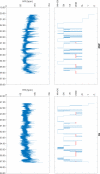Heart rate variability during sleep in children with autism spectrum disorder
- PMID: 27491489
- PMCID: PMC5106315
- DOI: 10.1007/s10286-016-0375-5
Heart rate variability during sleep in children with autism spectrum disorder
Abstract
Purpose: Autonomic dysfunction has been reported in autism spectrum disorders (ASD). Less is known about autonomic function during sleep in ASD. The objective of this study is to provide insight into the autonomic cardiovascular control during different sleep stages in ASD. We hypothesized that patients with ASD have lower vagal and higher sympathetic modulation with elevated heart rate, as compared to typical developing children (TD).
Methods: We studied 21 children with ASD and 23 TD children during overnight polysomnography. Heart rate and spectral parameters were calculated for each vigilance stage during sleep. Data from the first four sleep cycles were used to avoid possible effects of different individual sleep lengths and sleep cycle structures. Linear regression models were applied to study the effects of age and diagnosis (ASD and TD).
Results: In both groups, HR decreased during non-REM sleep and increased during REM sleep. However, HR was significantly higher in stages N2, N3 and REM sleep in the ASD group. Children with ASD showed less high frequency (HF) modulation during N3 and REM sleep. LF/HF ratio was higher during REM. Heart rate decreases with age at the same level in ASD and in TD. We found an age effect in LF in REM different in ASD and TD.
Conclusion: Our findings suggest possible deficits in vagal influence to the heart during sleep, especially during REM sleep. Children with ASD may have higher sympathetic dominance during sleep but rather due to decreased vagal influence.
Keywords: Autism; Autonomic system; Heart rate variability; Sleep.
Figures



Similar articles
-
Heart rate variability of typically developing and autistic children and adults before, during and after sleep.Int J Psychophysiol. 2018 Dec;134:15-21. doi: 10.1016/j.ijpsycho.2018.10.004. Epub 2018 Oct 9. Int J Psychophysiol. 2018. PMID: 30312640
-
Cardiac autonomic function in REM-related obstructive sleep apnoea: insights from nocturnal heart rate variability profiles.Sleep Breath. 2024 Oct;28(5):1987-1996. doi: 10.1007/s11325-024-03091-4. Epub 2024 Jul 1. Sleep Breath. 2024. PMID: 38951383 Free PMC article.
-
Comparison of Physiological and Biochemical Autonomic Indices in Children with and without Autism Spectrum Disorders.Medicina (Kaunas). 2019 Jul 7;55(7):346. doi: 10.3390/medicina55070346. Medicina (Kaunas). 2019. PMID: 31284658 Free PMC article.
-
The association between obstructive sleep apnea during REM sleep and autonomic dysfunction as measured by heart rate variability.Sleep Breath. 2019 Sep;23(3):865-871. doi: 10.1007/s11325-018-01779-y. Epub 2019 Jan 26. Sleep Breath. 2019. PMID: 30685848
-
[Physiopathology of the autonomic nervous system activity during sleep].Ital Heart J Suppl. 2001 Aug;2(8):840-4. Ital Heart J Suppl. 2001. PMID: 11582715 Review. Italian.
Cited by
-
Subjective and objective sleep alterations in medication-naïve children and adolescents with autism spectrum disorder: a systematic review and meta-analysis.Epidemiol Psychiatr Sci. 2023 Jul 20;32:e48. doi: 10.1017/S2045796023000574. Epidemiol Psychiatr Sci. 2023. PMID: 37469173 Free PMC article.
-
Protocol for targeting insomnia in school-aged children with autism spectrum disorder without intellectual disability: a randomised control trial.BMJ Open. 2021 Aug 25;11(8):e045944. doi: 10.1136/bmjopen-2020-045944. BMJ Open. 2021. PMID: 34433593 Free PMC article.
-
Pediatric sleep: current knowledge, gaps, and opportunities for the future.Sleep. 2023 Jul 11;46(7):zsad060. doi: 10.1093/sleep/zsad060. Sleep. 2023. PMID: 36881684 Free PMC article.
-
Neural Mechanisms of Qigong Sensory Training Massage for Children With Autism Spectrum Disorder: A Feasibility Study.Glob Adv Health Med. 2018 Apr 5;7:2164956118769006. doi: 10.1177/2164956118769006. eCollection 2018. Glob Adv Health Med. 2018. PMID: 29662721 Free PMC article.
-
A Comprehensive Investigation of Social Anxiety and Social Evaluative Stress in Autistic Children and Adolescents and Specific Learning Disorders.J Autism Dev Disord. 2024 Nov 2. doi: 10.1007/s10803-024-06624-8. Online ahead of print. J Autism Dev Disord. 2024. PMID: 39487282
References
-
- Benevides TW, Lane SJ. A review of cardiac autonomic measures: considerations for examination of physiological response in children with autism spectrum disorder. J Autism Dev Disord. 2013 doi:10.1007/s10803-013-1971-z. - PubMed
-
- Porges SW. The polyvagal theory: phylogenetic substrates of a social nervous system. Int J Psychophysiol. 2001;42:123–146. - PubMed
-
- Porges SW. The polyvagal theory: phylogenetic contributions to social behavior. Physiol Behav. 2003;79:503–513. doi:10.1016/S0031-9384(03)00156-2. - PubMed
Publication types
MeSH terms
Grants and funding
LinkOut - more resources
Full Text Sources
Other Literature Sources
Medical
Research Materials
Miscellaneous

